Impossible Monsters: Sunset Boulevard to Trog
with Chris Warrington
Fantasy abandoned by reason produces impossible monsters: united with her, she is the mother of the arts and the origin of their marvels.
(epigraph for capricho No. 43 from Goya’s “Los Caprichos”)
every golem-like the fantasy makes a world into which we press our love (“All the Rage”)
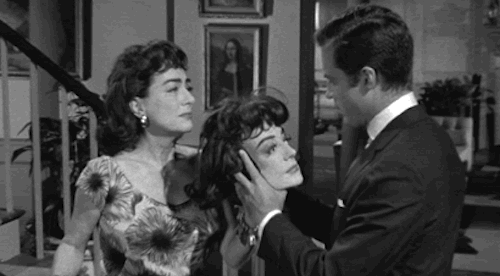
ETG: In 2009, Paul Foster Johnson arranged a screening of What’s the Matter with Helen? with Chris Warrington and myself. This film, part of the genre referred to variously as ‘hagsploitation’, ‘psycho-biddy thrillers’, ‘hag horror,’ and ‘grande dame guignol’ inspired me to begin a series of poems titled All the Rage and to collaborate with Chris Warrington, a painter.
CW: I remember your enthusiasm for What’s The Matter With Helen?, as well as your attraction / repulsion to the hag horror films. I myself was never partial to the genre, although at that point I had only seen What Ever Happened To Baby Jane? (1962, Joan Crawford and Bette Davis). I much preferred these actresses in their earlier glamorous and more sympathetic roles. Eventually, your enthusiasm rubbed off on me and I enjoyed the screenings and discussions that followed.
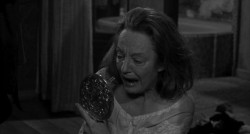
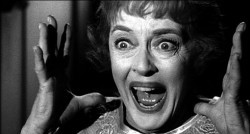

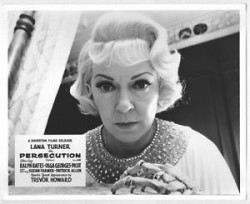
clockwise: Die! Die! My Darling! (1965, Talulah Bankhead), Hush...Hush, Sweet Charlotte (1964, Bette Davis), Persecution (1975, Lana Turner), Strait-Jacket
ETG: These films—primarily from the 60s and 70s—are amusingly bad in many ways, but star "older" A-list actresses who carry the B horror films into compelling melodrama and camp. Sunset Boulevard (1950, Gloria Swanson) both takes as its subject matter the aging Hollywood actress, and anticipates (establishes?) the psycho-biddy thriller as a genre.
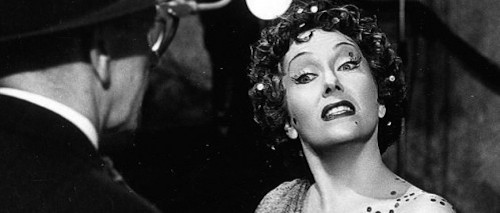
Norma Desmond, the lonely, out of work, silent film star, descends into a desperate homicidal fury as the young screenwriter she has hired to finish her screenplay attempts to leave her. After murdering him, she prepares for her role as Salomé and makes her "return" under the lights (of the police waiting to arrest her) in a kind of dissociative fugue state.
the picture of a picture in a picture / of the dream / that enfolds you
(“Love Has a Bitter Taste,” All the Rage)
Initially, I wanted to write about the films with the idea, or really the question, of whether or how they could be redeemed as feminist. Stymied on this front, I could only write into them as a feminist. And even in that capacity, it was / is difficult to read or write these films on those terms. They evoke the history of hysteria as a diagnosis—the result of witchcraft, possession, demonology, humours, vapors, a "wandering" womb, excessive desire, idleness, intellectual study, perverse desire, repressed memories, and so on—to excess. The murderous, menopausal, hysterical woman. Aging Hollywood star. Mommie Dearest and Mother Goddam.
Early on, we talked at length in your studio about how to move away from the sources that were compelling us so as not to be limited by them, how to weave a range of references into new work—in my case poems, in your case, drawings and paintings.
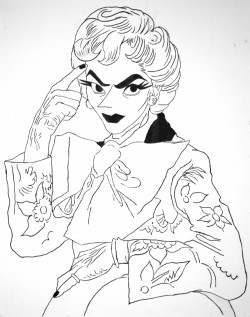
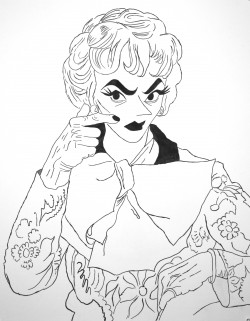
untitled drawings, 2012, ink on paper, each 19"x24"
CW: When we decided that a collaboration of some sort was in order, I wanted to make sure that I wasn’t merely illustrating your poems. My idea was to come up with my own actress / "hag." I made a series of drawings based on images taken from two books in my collection: Miss Craig’s Face Saving Exercises (1970) by Marjorie Craig and Polly’s Principles (1974), by Polly Bergen, another actress from Hollywood’s Golden Age. Both books are full of beauty tips for aging women, and date from the same era as the films. So my actress / "hag" is a hybrid of images culled from these sources. But I was also thinking of Durer’s Melancholia and Goya’s The Sleep of Reason Produces Monsters when I was making the painting. I titled it At Arm’s Length—from the last line of the last poem in the chapbook we made together (All the Rage, flynpyntar editions, 2013). It seemed appropriate for this figure to be pointing to her head / face—alluding, perhaps, to madness, or to aging and mortality. I think of it as an allegorical figure.
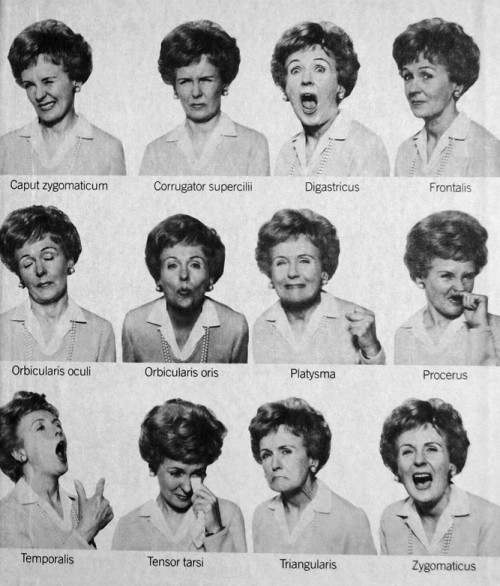
ETG: For my part, the poems became strangely empathetic, psychological, character studies based on the individual films. The studies involved writing through the melodrama, hysteria, mania, and / or psychosis that usually played out on the isolated estates of these single white females. The madwoman no longer confined to the attic. In most instances the women, husbands dead or gone, are driven to the edge over the loss of sons (to younger women), lovers (to other women), or status tied to men that they had or should have or could have had. Strait-Jacket is anomalous in that it is about a mother-daughter relationship, a kind of hysterical lineage, the passing of homicidal breakdown from mother to daughter. The poem, “All the Rage,” written after this film is the central poem in the series for this reason. I wanted to consider that there was a continuity to the fury of these women, a symptom of patriarchy?
Jack Warner is quoted as saying of Davis and Crawford in Baby Jane, “I wouldn’t give you one dime for those two washed-up old bitches.” There’s no doubt sexism is at work, but I think what we came to was that the films appear to condense all sorts of cultural complexities, but in reality they are reductions of those complexities and therefore limited in what they can say about them. Fury, madness, can be the result of restrictive, repressive, and unforgiving constraints, but ultimately the films raise more superficial questions—what was this obsession with crazy white ladies of means? Was it simply that these actresses needed work and no one knew what to do with them?
CW: I feel that the point of our collaboration was, in part, about asking these questions, and ultimately trying to figure out why we found these films so compelling. For me, they just present more extreme and grotesque versions of the issues explored in so-called “women’s pictures,” but with neither the empathy, nor the great style of those films. In that sense they are more purely camp, in their self consciousness and bad taste. In her review of the Bette Davis film The Anniversary (1968), Renata Adler called it “the Terrifying Older Actress Filicidal Mummy genre,” going on to say that “the genre isn't that distinguished after all.” The films are not so great as art, but totally enjoyable as camp.
ETG: Right, and this posed a problem for me in writing the poems. The camp aspect of the films is the part that I found to be untranslatable. Placing your drawings or paintings alongside my poems, however, created that "wink" that is the crux of camp.
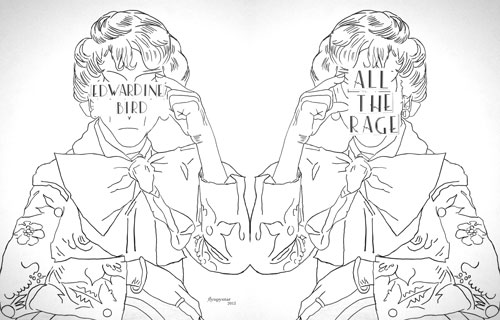
CW: I’ve been really interested in the history of camp and camp imagery for a long time. I think this was the first time I’ve tried to make something so explicit. But, again, I didn’t want to just make a copy of a film still, or paint a picture of Bette Davis or Joan Crawford specifically. I was trying to make something restrained—a figure that alluded to the actresses / characters in the films. Everyone who sees the painting identifies the figure differently. One person identified the figure as a drag queen wearing office attire from the 1980s. I’ve also gotten Lypsinka, Cruella DeVille—even Ruth Bader Ginsburg! So, in the end, I made a painting that not only addressed camp imagery, but might be camp itself.
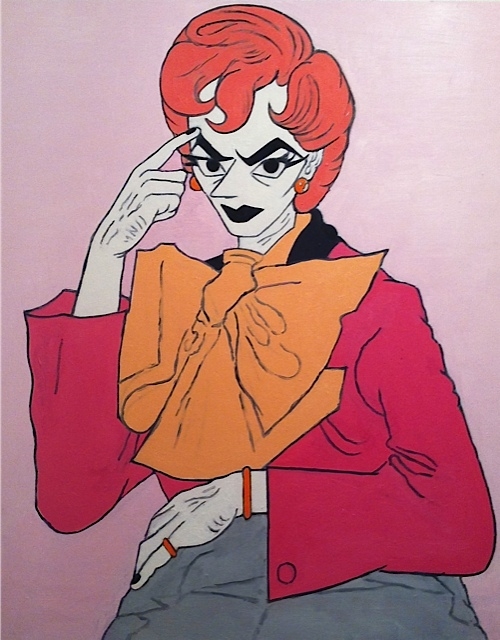
ETG: Similarly, I didn’t want to be writing poems that were explicitly "about" the films, or that narrated them in any way. Yet it did feel necessary to allude to the films and to the serial nature of the poems, so our chapbook concludes with a filmography. In both of our attempts to move away from the sources, the resulting poem or image assembles a kind of scene, a gestural figure in space: your blank backgrounds, my abstract studies. Two books were particularly useful to me in thinking through the process of writing poems in relation to film: You Are the Business by Caroline Dubois, translated by Cole Swensen (Burning Deck) and Turneresque by Elizabeth Willis (Burning Deck). What worked for me in these books, and what I think we wanted to get at, is the way that the selection of films coheres to articulate a cultural context that the creative work can then explore via an abstraction of the narratives and subjective experience.
CW: I feel like of all of the examples of the genre Dead Ringer may be the most classical, the closest to a complete statement and a successful film. Do you agree? What was your process—from viewing Dead Ringer (1964, Bette Davis) to writing “The Horror of Apartments”?
ETG: I do think Dead Ringer is just a great suspense film. Bette Davis on Bette Davis. If she and Joan Crawford couldn’t work together (as in Hush...Hush, Sweet Charlotte), Bette Davis could certainly work with herself. There was so much that captivated me in writing the poem after this film—the twinning, the mirroring, and the double bind of escaping one trap and emerging into another. It’s like a dream where you keep opening doors and emerging into the same room. And I think the experience of writing these poems is a bit like that, too—working with all these variations on—and distortions of—the themes of femininity, aging, and madness...looking for a way out.
In the soft space, the dream space. It turns and turns
at arm’s length
(“The Horror of Apartments,” All the Rage)
Selected Filmography:
Sunset Boulevard
Whatever Happened to Baby Jane?
Strait-Jacket
Hush, Hush, Sweet Charlotte
Whatever Happened to Aunt Alice?
What's the Matter with Helen?
Who Slew Auntie Roo?
Die! Die! My Darling
Dear Dead Delilah
Persecution
Berserk!
Dead Ringer
Nightwatch
Trog
...
Chris Warrington attended the Pennsylvania Academy of the Fine Arts in Philadelphia, where he studied painting. He has been in a number of groups shows, including exhibitions at the Earl McGrath Gallery in New York, the William Shearburn Gallery in New Mexico, and at AR/GE Kunst in Bolzano, Italy. His work was presented in a solo show at 443PAS in New York, where he also curated several exhibitions. His work has been featured in the pages of D Magazine (D is for Drawing). He lives and works in Ridgewood, NY.
E. Tracy Grinnell is the author of Hell Figures (2016), portrait of a lesser subject (2015), Helen: ...
Read Full Biography

